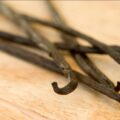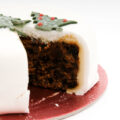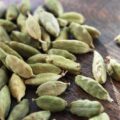The King of Spices-Vanilla
Michal Haines
Maybe it should be known as the Queen of Spices, but the little trick vanilla played on its own species is wonderfully elegant.
Part of the largest group of flowering plants in the world, the vanilla planifolio, is the only one of its kind with edible fruit. Fruit that we know the taste of with such familiarity that in a blind test situation, it is chosen accurately 70% of the time. For the poor 30% who don’t recognise it, I suggest we can do nothing more for them.
The irony of this wonder plant is that it in order to have the honour of bearing edible fruit it has had to give up its aroma.
Almost totally scentless, vanilla must struggle along in its life being the bearer of taste without the intoxicating aroma that its fellow orchids can bring.
The Aztecs were fast to recognise its virtues and documentation of Cortes indulging in drinks of chocolate laced with vanilla and sweetened with honey in 1520 show they were already more than familiar with it. Cortes was particularly fascinated by how venerated vanilla was to the Aztecs. Considered the most feminine of foods, her abundance of seeds symbolised her fertility and her purity is represented by her sheathed calyx meaning accidentally fertilisation is impossible-another little trick of the plant.
Cortes returned to Spain with chocolate, introducing it as xocolatl , its original Aztec name. The black pod or tlilxohitl he had so fallen in love with returned to be introduced as the far more evocative vaina, from the Latin vagina.
The Spanish began importing vanilla around this time, establishing factories to manufacture chocolate flavoured with vanilla.
It became quite the ingredient back in the day, being heralded as an aphrodisiac and a stimulant and as usual, clever marketing made it something that one just couldn’t live without.
Unfortunately for humans, the propagation of vanilla outside of its natural habitat was very slow to take on. As early as 1733, plants were being raised but without success of fruit. It seemed that tender care and attention just wasn’t enough for the Queen of Spices.
It wasn’t until 1833 that a well known botanist worked out that pollination had to be undertaken by a very small sting-less bee, unique to the vanilla’s natural habitat of south east Mexico and Central America. No bee meant no pollination and no fruit. He devised a way to hand pollinate the vanilla to imitate the bee.
Hand pollination was undertaken using little spiked bamboo sticks and success was finally at hand. By the early 20th century, vanilla was being grown on Reunion Island, in Tahiti, parts of Africa and Madagascar. All plants were being fertilised in the same labour intensive manner using hand pollination. The very same method that is employed today.
This is a labour of love. Flowering takes place over two months at which time 50 to 150 selected flowers per plant will be hand pollinated and those successfully pollinated flowers will bear fruit within six weeks. It is another six to nine months before the green pods begin to yellow and are considered ready for harvesting. As the pods do not mature at the same rate, there can be a three month period of harvesting undertaken to get a full harvest.
The next stage involves kiln drying for up to twenty four hours in order for the natural enzyme vanillin to be produced on the surface of the pod itself.
Out into the sun they go for more drying and at the end of each day all the beans must be gathered together and wrapped up in blankets to protect them from the night air and moisture.
This continues for a period that can exceed six months before the pods are once again gathered together, graded and strung into bundles of 60-100 beans ready for export and further processing to make extract, sugar, pastes for the commercial and domestic markets.
By this time a single vanilla pod will have been handled up to 100 times.
The demand for vanilla over the centuries grew rapidly and inevitably the demand outweighed supply. Some clever scientist worked out that by taking the waste sulphite liqueur of paper mills and coal tar extracts they could make something that imitated real vanilla and called it vanilla essence. With the expansive growth of commercial baking and ice cream manufacturers, it seemed a sensible and price conducive thing to create rather than use the original. At one stage it even threatened the natural vanilla industry as more and more people chose the imitation over the real due to price, a sad inevitability but one so often seen when taste goes up against the dollar.
As consumers, remember the golden rule …..For better taste and scent, go for extract. Stay clear of essence.
Natural vanilla extract is made from soaking finely chopped cured vanilla pods in alcohol. A portion of the alcohol is then distilled leaving what we know as vanilla extract and around 35% alcohol.
Look out for those well labelled with 100% natural vanilla extract and some indication of alcohol content.
Vanilla pastes have become increasingly popular but read the labels carefully as many contain dextrose or corn syrup, glycerine and added sugar. These can often be created from both the seeds and pod itself leaving you with a mixture that can be overly woody rather than floral in flavour due to the inclusion of the otherwise discarded pods.
Vanilla powder is another one to watch out for. Cheap versions are merely mixtures of powdered vanilla essence and sugar. Very rare are the formats that use the vanillin which naturally rises to the surface of the bean itself in the drying process and is scarped off and mixed with high grade natural sugars. A simple and tasty version is to simply scrape the seeds from one or two pods and mix them into good quality sugar to infuse.
To go one step further you can even rate your extract by where the vanilla has been grown.
Mexican vanilla held the monopoly for over 300 years and is still held in high regard as possessing the best flavour, albeit subtle in comparison with its cousins. Delicate top notes set this variety apart.
Bourbon vanilla comes from three main sources-Madagascar, the Comoro islands and Reunion. With a more pronounced body it is the preferred choice for those who are in the extracting industry.
Indonesian vanilla, until recently has been a mixed bag. Much of it is used in the production of syrups and higher quality artificial vanilla essence. Now more is being carefully handled and cured opening up another section of the market that may well prosper for top quality vanilla.
West Indian is a lower grade to Bourbon and is generally used for perfume production rather than culinary applications.
Tahitian vanilla is produced both in Tahiti and Hawaii. With low vanillin content and a taste that many official tasters do not rate at all, it is now becoming a new growth market for Tahiti. Often seen transformed into soaps, shampoos and hand creams for the tourist market, there are exceptions where small growers are taking total control to create beautiful quality vanilla.
Each variety has something to offer in the kitchen. Be it to infuse sugar for baking cakes and biscuits, infusing alcohol or making sauces for both sweet and savoury dishes, the vanilla bean truly is the queen of spices.







Hi Vicky,
tamarillos I just adore.
One of my favourites is simply poaching tamarillos with one scraped out vanilla pod and cook till they begin to fall apart.Put through a sieve to get rid of the seeds and mix through a tablespoon of ornage blossom water.Add to cocktails and pour over desserts or be daring and try with pork and chicken.keep the seeds in for more of a compote version.
Hi Helen
I love the garden and kitchen show every
Saturday morning. I was waiting to see if anyone called on Saturday 25/4 to confirm that guava’s are ok to freeze until you want to make guava jelly. Did I miss this answer?
Also, with tamarillos just around the corner, when my husband and I were in Bali we ate tamarillo compote with cereals for breakfast and they were beautiful. I think they had vanilla beans that had been preserved with them. Do you have some suggetions for preserving these delicious fruit.
Regards
Vicky